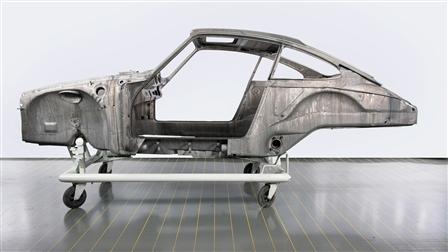
Body work and Paint Removal
Perfect body care: The 911 T bodyshell brings the year (of construction) 1973 back to life
The bodyshell is fixed firmly in place, but not under pressure.Just as if Helmut Newton had set the scene for one of his brilliant photographs, the sweeping metal form sits majestically on the straightening bench, positioned with millimetre accuracy:proud, bare and ice-cold.According to Jochen Bader, Head of Factory Restoration, this is nothing less than of work of art.A 911 in its purest form.
The bodyshell is being returned to its original form.For the first time since starting work on the 1973 911 T, it's like travelling back 37 years: this is approximately what the bodyshell looked like back then.After restoration has been completed, the car will be raffled off among
In order to complete their mission to “Revive the Passion”, a joint project of the PCA,
Such moments are important during revitalisation of a classic vehicle and have a great influence on the rest of the full restoration process.After all, the condition of the body is always the great unknown in expert refurbishment of a vehicle – until the true condition is revealed.The complex sheet metal work may become almost unending if it should transpire at the critical moment that there is not much of the body left, with the result that the vehicle has to be almost completely rebuilt with a great deal of sensitivity and experience.But this is not necessary for the 911 T.This may be due to the climate of the American West Coast or the fact that previous owners treated the vehicle with care.In any case, the bodyshell that emerged from the paint removal bath gets top marks.
The paint removal bath and the necessary preparations for this are therefore particularly important.First of all, specialists open all cavities in the body in order to allow the caustic solution free access into the very last corner.This is so that the fluid can completely expose all locations affected by corrosion.Equally important is the cleaning action of the caustic solution on subsequently-treated body parts.It is, after all, quite normal that vehicles which have reached an age of well over thirty years have already made their acquaintance with body filler or subsequently applied plastic matting.And even if this is done well, the repair materials simply do not belong there.The caustic solution removes them.They are then completely flushed out and neutralised thanks to the cavities created beforehand.
The real meaning of “into the very last corner” can be explained quite well for the 911 T by taking as an example a thin metal tube that emerges from the rear end of the car.This extends on the driver’s side from the rear end to the door frame and can be seen only because the rear side sections were removed.The wire pull that allows the driver to open the bonnet from inside via a lever runs through this tube.Even this thin tube is completely clean both inside and out and in good condition.
There is actually no fixed schedule for the bath.Experts repeatedly check the progress of cleaning and decide individually how long the caustic solution should still be allowed to act.This took only a few days with the 911 T.Sometimes weeks may be required.Thoroughness has priority over everything else, particularly since this does not mean that any time is lost in the
Now, the body is installed on the straightening bench.And it will remain there for some time.It is free of all hidden defects, but is by no means finished.In fact, its reconstruction is just beginning.However, that must wait for now.In the next step, it is the turn of the engine of the 911 T. Here, the task is to restore the six-cylinder flat engine to its full power of 140 hp.




























